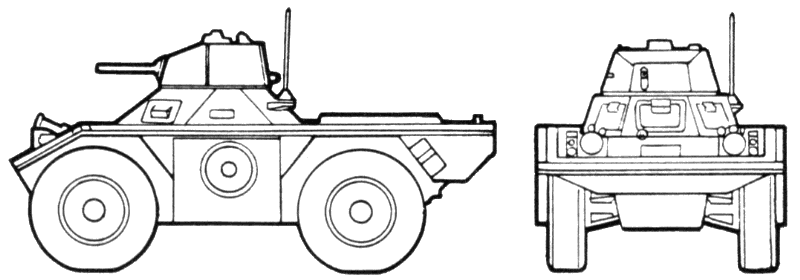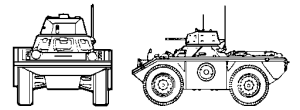A replacement for the Daimler Dingo scout car of World War II, the Daimler Ferret was produced from 1952 to 1971.
Throughout its production life, the basic hull remained unchanged, but more powerful engines and different turrets were installed.
The Ferret has an all-welded steel hull that is divided into three compartments: the driver's compartment in the front, the fighting compartment in the center, and the engine compartment in the rear.
The driver sits in front with three hatches: one in front and one on each side. Each hatch has an integral periscope.
The front hatch may be folded down onto the glacis plate. This can be fitted with a splinter-proof windscreen with wiper blade and electric motor.
The two side hatches open upwards when not in a combat area.
In the center is a manually-operated turret.
A hatch cover in the roof rear can be locked in three different positions.
A rear part of the turret folds down horizontally for use as a seat.
In front of the turret roof is a sight periscope for aiming the turret-mounted machine gun.
A vision slit with glass block is in each side of the hull below the turret ring.
Two hatches are at the rear of the fighting compartment.
A hull escape hatch is on each side between the front and back wheels.
These are covered by a spare tire on the left and a stowage box on the right.
The basic scout car has no NBC system, no night vision equipment, and no amphibious ability.
A deep-fording kit has a collapsible bellows-type collar that goes around the top of the commander's hatch.
Another fits at the very rear of the hull.
The Ferret Mk 3 and Mk 4 models have a collapsible screen that goes around the top of their hulls which allows travel across lakes and rivers using their wheels for propulsion.
The Ferret Mks 1, 2, and 3 can carry steel channels on the front that are used for crossing trenches.
A Rolls-Royce B60 Mk 6A six-cylinder in-line water-cooled gas engine develops 129 horsepower at 3,750 rpm.
Drive is transferred to all four wheels with a fluid-coupling transmission having five speeds in each direction.
The waterproof engine will run when completely submerged without any preparation other than venting the crankcase breather pipe.
Run-flat tires are each suspended with a shock absorber and single coil spring.
These vehicles have been phased out of British service.
The Fox armored car is a further development of the Ferret light scout car.
Recognition features:
- Two large wheels on each side.
- A spare wheel center-mounted on the left side.
- Square sides.
- Some have turrets, some do not. Turret is flat-topped and angular shaped.
- Angular shaped hull.

